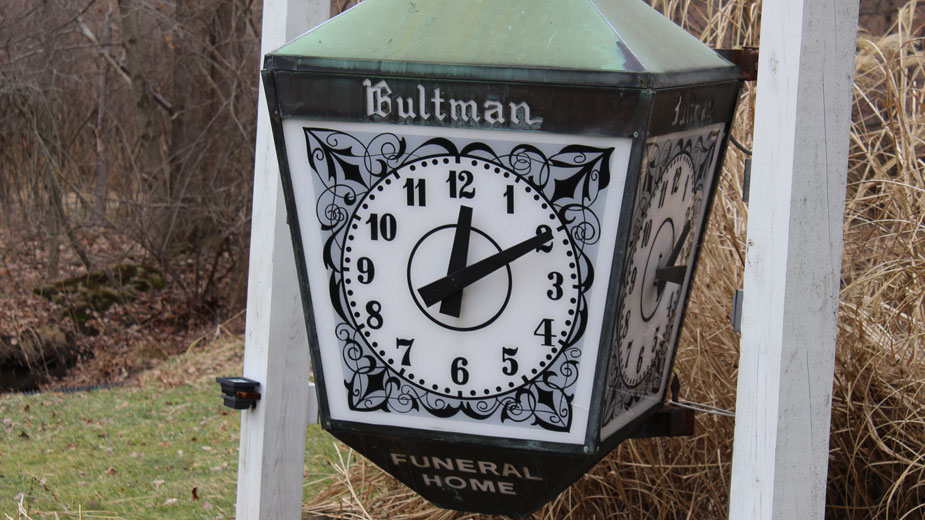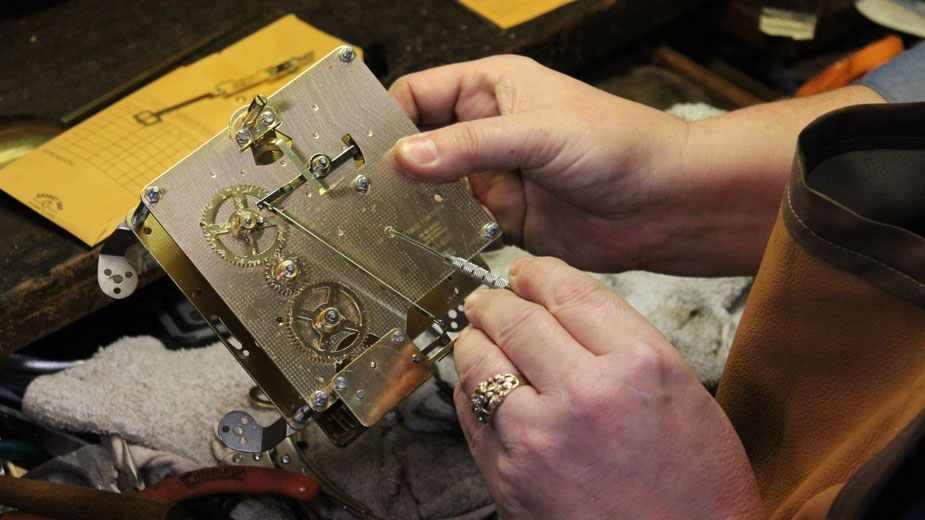The article appears below, here is a link to the original printed version.
Youngstown Business Journal Pine Knoll Clock Shop
One correction; my street number is 1749 Mercer Grove City Road.

 Dorrin Mace uses dental picks to clean out oil buildup on clocks.
Dorrin Mace uses dental picks to clean out oil buildup on clocks.
Youngstown Business Journal Pine Knoll Clock Shop
One correction; my street number is 1749 Mercer Grove City Road.
Company News
Work Keeps Ticking Along at Pine Knoll Clock Shop
MERCER, Pa. – For
horologist Dorrin Mace, an interest in clocks stretches back to the
Revolutionary War. His personal story starts a little closer to today,
but the items that caught his attention go back to the founding of the
nation.
“In 1969, my grandfather
died. They had a house that was granted to them after the Revolutionary
War, so about 1780. They never threw anything away and one of the summer
kitchens was full of every clock that house ever had,” Mace says from
his workshop. “I was just fascinated. I wasn’t very old, but I was
fascinated enough to know that’s what I wanted to do.”
Today, 50 years later, that fascination has grown into Pine Knoll Clock Shop, 1479 Mercer Grove City Road in Mercer, Pa.
Inside his workshop, Mace
repairs and refurbishes clocks of all ages, styles and conditions. In
one corner is a red and white Coca-Cola clock from the 1980s, while a
piece made in France in the mid-1800s sits on a cabinet across the room.
Leaning against the cabinet is one of Mace’s rarest finds to date: a
McClintock master clock. The clocks were once used by banks and
courthouses to control individual clocks throughout their offices via
electrical pulses that went off every minute.
“It played four different
melodies so you knew exactly what time it was. Instead of playing four
parts of a melody, this one had four distinct melodies. It played off a
drum over electric pickups to the main clock,” he says.
What makes the find so
exceptional isn’t its condition – most of the clock is “in a million
pieces in a bag” – but that it’s just one of three Mace knows to still
exist. Used largely in the 1920s and 1930s, the McClintock master clocks
were between 12 and 15 feet tall with large amounts of brass and
copper. When the United States entered World War II, many were scrapped
to aid the war effort.
“I don’t know how this one
survived, but I know there are three of these and none of them work. I’m
more than excited to have this,” Mace says of the clock he found in a
California junkyard. “I don’t know the value on this and it doesn’t
really matter.”
In his eyes, all clocks are
equally valuable. He’s worked on pieces with just a $10 price tag and
pieces designed by L.C. Tiffany. Just as much care is given to the $10
clock brought in by a boy who received it as a gift from his grandfather
as is given to the one designed by the man best known for stained-glass
works for Tiffany & Co.
“It may be a $10 clock, but to him it means everything,” Mace says.
Among the larger projects Mace has had is a clock weighing
about 700 pounds from Bultman Funeral Home in New Orleans, the oldest
funeral home in the city before it was destroyed by Hurricane Katrina.
Mace purchased the clock from another clock repairman based in Michigan
and brought back into working condition. He estimated that had the work
been done for a customer, it would have been a $10,000 repair.
Today, it sits outside Pine Knoll.

Mace started repairing
clocks as a hobby, eventually offering help to others when he was about
18. As the years went on, it turned into a side job before coming into
its own as Pine Knoll Clock Shop in 2001.
“I started in the basement
and then the basement took over the dining room, which took over the
living room. It was overwhelming and we bought our first building,
thinking I’d work 20, 30 hours a week,” Mace says. “I was at a year and a
half wait on repairs, which you shouldn’t do. That really said to me
it’s time to leave [my other job].”
Today, his backlog is
usually around 12 weeks, with the time largely depending on the degree
of repairs needed – small adjustments can be done in his workshop – and
the availability of parts. When Mace started working on clocks, he says,
there were 15 parts suppliers, down to just two today, which can make
sourcing replacement parts a challenge.
“I have a huge group of
people that follow me – our blog has about 200,000 followers – that
include repairmen in Israel, South Africa and around the world that I
can contact,” he says. “There are some things that you can’t quote, that
you have say ‘I’ll call you back when I find the part.’ But cleaning,
oiling, adjusting suspensions, we know how long it takes to do that.”
In his arsenal of tools,
little is specific to clocks, he says. Among the ones he uses most often
are Phillips head screwdrivers – about a dozen because of the wide
variety of screws used in clocks over the past couple centuries – and
dental picks. One of his more prized tools is a set of carbide bits made
in France in the late 1800s.
“You use them as files to clean out pivots. They’re great in small areas,” he says. “Nothing here is a high-end tool.”
 Dorrin Mace uses dental picks to clean out oil buildup on clocks.
Dorrin Mace uses dental picks to clean out oil buildup on clocks.
After repairs are made, he
lets clocks run for up to a week to ensure that there aren’t any more
problems with it and that everything is running smoothly.
Beyond fixing clocks, Mace
has also gotten into selling them. The front portion of Pine Knoll Clock
Shop is full to the brim of pieces repaired or built by Mace, ranging
from cuckoo clocks to towering grandfather clocks. There’s also the
Green Line, developed by Mace as a way to recycle discarded materials.
“I saw so much waste. My
wife and I are hippies, for lack of a better term,” he says with a
laugh. “We saw flooring that couldn’t be used and had some worn damage
but once it’s sanded, it’s just gorgeous. Fencing that’s been damaged by
weather can be beautiful. You’re saving resources.”
He’s turned old records
into timepieces, as well as hubcaps, pieces of tin ceilings and, at one
point, even gears from Harley Davidson motorcycles.
And even with the
increasing use of smartphones and watches, Mace says business is as good
as ever. His clientele stretches across generations as younger people,
he observes, fall in love with one particular aspect of clocks.
“It’s the sound of a clock
ticking. There used to be an advertising slogan: ‘The heartbeat of the
home.’ People are remembering that,” he says. “It’s like reading a book.
Having an e-reader is fine, but there’s the tactile feel of the book.
Watching the hands ticking is just phenomenal.
Pictured: Dorrin Mace, owner of Pine Knoll Clock Shop, with his McClintock master clock, one of three he knows to exist.
Copyright 2019 The Business Journal, Youngstown, Ohio.

No comments:
Post a Comment
Note: Only a member of this blog may post a comment.